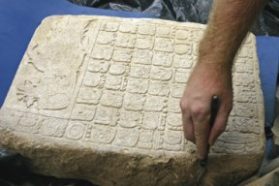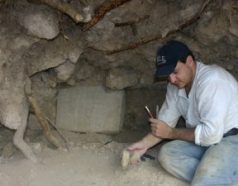Stone tablet may solve Maya mystery
A panel covered with hieroglyphs appears to connect little-known ruins with an ancient Maya city.
By Emily Sohn
For decades, “Site Q” has been a mystery city. Archaeologists suspected that this Maya settlement existed more than 1,400 years ago, but there was little evidence to link it with certainty to any known ruins.
Now, scientists say that they’ve found the evidence that they’ve been looking for. At an archaeological site in Guatemala, Yale University researcher Marcello Canuto and his team dug up a stone panel covered in symbolic characters called hieroglyphs. Canuto and his colleagues say that the writings finger the place, called La Corona, as Site Q.
 |
|
Hieroglyphs carved into this stone panel, found last April, indicate that an ancient Maya settlement in Guatemala is the mysterious Site Q. The panel also shows two lords facing each other as they perform a ceremony.
|
| Photo by Roan Mcnab, Yale University |
The possibility that Site Q existed arose about 40 years ago, when there was a sudden influx of carved artifacts being bought and sold as antiques. The objects were supposedly from the Maya city of Calakmul, in what is now southern Mexico. Analyses of the objects, however, showed that their style differed from traditional Calakmul artifacts.
Instead, researchers proposed that the objects were stolen from a city, unknown to archaeologists, in the lowlands of Guatemala. They called it Site Q.
The newly discovered stone panel is covered with more than 140 hieroglyphs that span a period from A.D. 658 to A.D. 677. The markings describe two kings who have been linked to Site Q, and they match the style of hieroglyphs previously found on a stolen panel that mentioned the same kings.
The symbols tell the story of one king’s journey to Calakmul. It seems that he was looking for help after a more powerful Maya king threatened to conquer Site Q. The markings also mention a ceremony that was held when the king reestablished his kingship. Apparently, he won that battle.
 |
|
Yale University archaeologist Marcello Canuto with a hieroglyph panel from Site Q.
|
| Photo by Roan Mcnab, Yale University |
Researchers are now searching for more artifacts to confirm this discovery. They also want to see whether all stolen Site Q artifacts came only from La Corona and not from nearby Maya sites as well.







